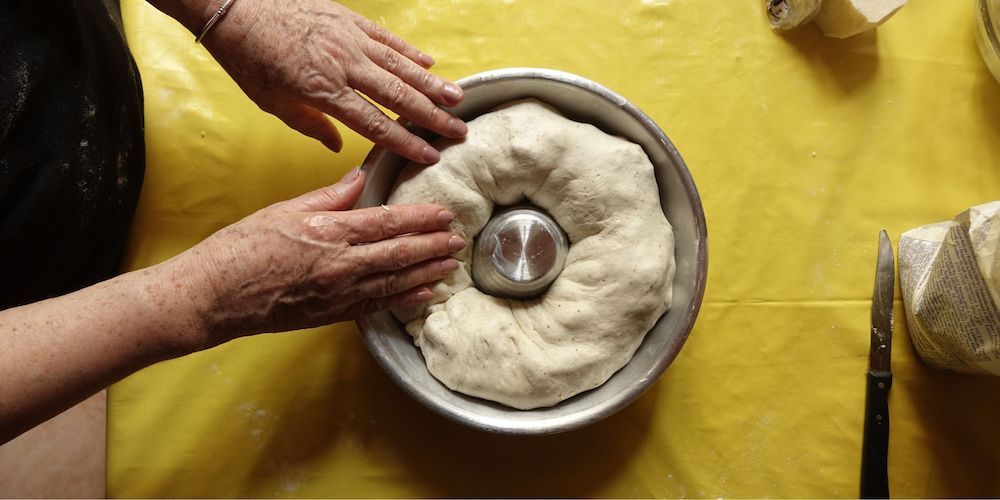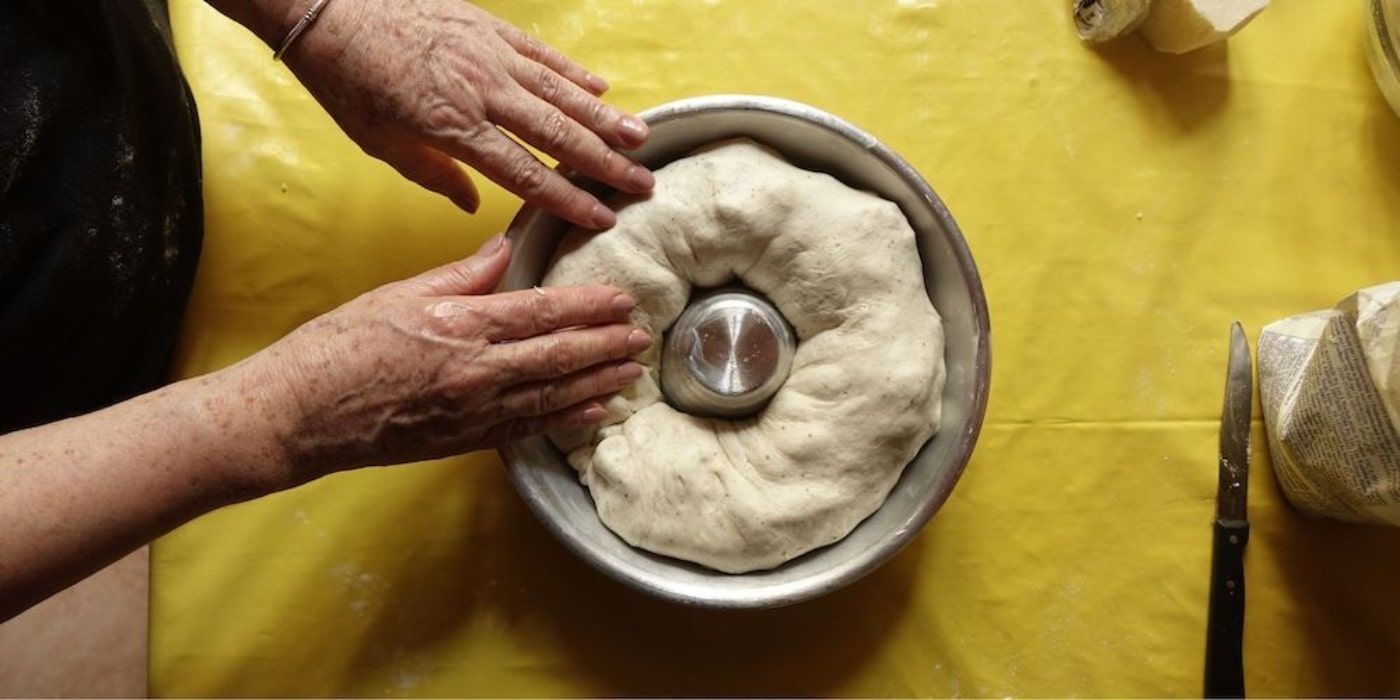Casatiello is an emblematic and evocative dish, a true gastronomic emblem of Naples' Easter tradition. In addition to its delicious and refined taste, it carries with it a centuries-old history and important ancient symbolism, which elevate it to a true icon of the local cuisine.
Let's discover together the secrets of this typical Neapolitan Easter bread: its origins, curiosities, ingredients and how to cook Casatiello to perfection, ending with the metaphorical and evocative meanings that contribute to the charm of a recipe that cannot be missing on the tables of all Neapolitans.

Casatiello: the origins of a culinary symbol of Naples

In Italy, the Easter menu is particularly rich in classic dishes of absolute excellence, prepared with the typical products of each region, each offering unique flavors, stories and traditions.
In the extraordinary gastronomic culture of Naples, Easter recipes such as the Neapolitan Pastiera, Timballo di Pasta, or the inevitable Casatiello, represent a fundamental element full of celebratory meanings, both from a religious perspective and in terms of family ties.
The presence of Casatiello, in particular, is attested at least from the 16th-17th century. But the origins of this dish are probably even older, dating back to the times of Greek and Roman Naples when seasoned breads were used during spring festivities in honor of Demeter and Ceres.
The term "casatiello" derives indeed from the Latin caseus (meaning "cheese"), and in that context, rich and decorated breads were offered to obtain divine favors for the harvest and soil fertility.
With the advent of Christianity, this practice was transformed and adapted to become an integral part of Easter celebrations, reaching the present day as a sort of bridge with past traditions.
In this sense, it’s no coincidence that this recipe developed in the city of Naples, a place that has long been an incredible crossroads of culinary cultures and traditions, which over the centuries have mixed to give life to unique and distinctive foods.
Moreover, Easter festivities hold considerable importance in the Neapolitan capital, and Casatiello has developed as the ideal food to celebrate this occasion, due to its perfect combination of gastronomic culture and religious significance.
We will delve into the symbolic aspect later on; for now, let's move on to discover the ingredients and how to cook Neapolitan Casatiello.
Visit Naples by purchasing the Naples PassHow to cook Casatiello: ingredients and recipe

As a traditional dish of Easter festivities in Naples, Casatiello embodies conviviality and a strong sense of community and belonging. Therefore, it should be enjoyed in company, and for this reason, the ingredient quantities we are about to list are for 8 people.
Let's start with what is needed for the dough:
- 00 flour, 400 g
- Brewer's yeast, 17 g
- Lukewarm water, 360 ml
- Lard, 100 g
- Salt
- Pepper
For the filling, instead, we need:
- Neapolitan salami, 200 g
- Cicoli (pork fat), 200 g
- Pecorino Romano cheese, 100 g
- Grated Parmigiano Reggiano cheese, 100 g
- Spicy Provolone cheese, 100 g
- Lard, 10 g
- 5 eggs
- Pepper
To make this recipe from the Neapolitan Easter tradition, let’s start by mixing in a bowl the flour, lard, salt, pepper, brewer's yeast and lukewarm water until we get a smooth and soft dough. After covering it with a cloth or plastic wrap, let it rise for several hours (or overnight if prepared the day before).
Now we need to focus on the filling: in a bowl, mix the diced salami, cubed cheeses, cicoli, ground pepper and beaten eggs until getting a homogeneous mixture.
When it's finally ready, roll out the risen dough on a work surface, then evenly spread the diced filling on top before rolling it all up, sealing the ends. Let’s set aside a small piece of dough, which will be useful in a moment.
Next, place the roll we’ve obtained in a Casatiello mold or even just a bundt cake mold, and let it rise again for about 60/90 minutes. Before this, however, we have to add the whole eggs inside the dough, enclosing them with small cords made from the dough that we set aside. In practice, we form a sort of cross over each egg.
Once the leavening is complete, the process to prepare Casatiello is almost finished: let’s use the egg yolk and the lard to brush the surface and bake at 180 degrees Celsius in a preheated oven for 40/50 minutes. For perfect cooking, Casatiello should have a golden color.
Before removing it from the mold and slicing it, let it cool for about half an hour. Then. all that's left to do is to serve and enjoy this delicious recipe from the Neapolitan Easter tradition in good company.
The secrets of Casatiello, a cultural heritage to be savored

As we have already highlighted, Casatiello is closely associated with Easter festivities, representing a true gastronomic symbol for the entire city of Naples.
Its shape itself resembles the crown of thorns of Jesus, emblematic of sacrifice and suffering remembered on Good Friday. The presence of eggs and crosses formed with the dough are metaphors for a new life, images of hope that in the Christian tradition are associated with the resurrection of Christ.
Ingredients such as cheese and cicoli (pork fat) not only contribute to the excellent flavor of the dish but also have their own particular allegorical meanings. They represent abundance and prosperity: cheese is associated with the idea of nourishment and sustenance, while cicoli symbolize the richness of the territory as a caloric ingredient.
For all these reasons, the preparation of Casatiello is often seen as a sort of rite of passage in Neapolitan families. Mothers and grandmothers pass down their recipes and preparation techniques to the next generations, often involving the younger members of the family.
In this way, not only are the culinary traditions of the territory preserved, but family ties are also strengthened through work and the sharing of stories and memories.
Not only food: taste the wines of the regionThe variations of Casatiello and the difference with Tortano

In addition to the classic version of Casatiello, there are numerous regional variations reflecting the diverse culinary traditions of various areas of Campania and the surrounding regions.
For instance, some recipes may include the addition of cooked ham or bacon, which impart a stronger and spicier flavor to the dish. Other variations may involve using different cheeses or the use of ingredients like onions or olives.
There are also sweet versions of Casatiello, prepared by adding ingredients such as sugar, dried fruit, candied fruits or chocolate. Sweet Casatiello can be served as an Easter dessert, offering an interesting contrast to the classic savory version.
All these regional variations are quite fascinating as they contribute to adding further diversity and color to the tradition of Casatiello, thus keeping its history and cultural significance alive in different local communities.
Lastly, it's important to note the difference with Tortano, another specialty of Campanian cuisine. Tortano is an Easter bread very similar to Casatiello in both shape and ingredients and is mainly found in the Avellino area.
What distinguishes it from Casatiello is primarily the use of eggs: in the Tortano, whole eggs are not inserted; instead, only hard-boiled eggs cut into wedges are placed inside the dough.
About the author
Written on 21/03/2024




Alessandro Savino
A delicious recipe, symbol of the Easter tradition in Naples: let's discover together how to cook Casatiello, a typical bread of Neapolitan cuisine.